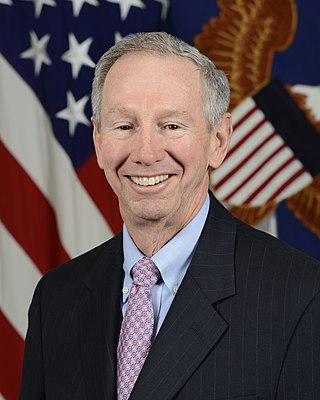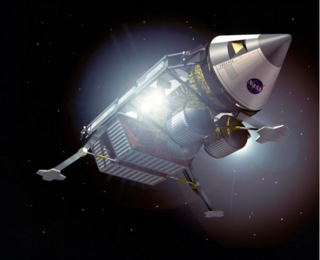Related Research Articles

The Planetary Society is an American internationally-active non-governmental nonprofit organization. It is involved in research, public outreach, and political space advocacy for engineering projects related to astronomy, planetary science, and space exploration. It was founded in 1980 by Carl Sagan, Bruce Murray, and Louis Friedman, and has about 60,000 members from more than 100 countries around the world.

The Constellation program was a crewed spaceflight program developed by NASA, the space agency of the United States, from 2005 to 2009. The major goals of the program were "completion of the International Space Station" and a "return to the Moon no later than 2020" with a crewed flight to the planet Mars as the ultimate goal. The program's logo reflected the three stages of the program: the Earth (ISS), the Moon, and finally Mars—while the Mars goal also found expression in the name given to the program's booster rockets: Ares. The technological aims of the program included the regaining of significant astronaut experience beyond low Earth orbit and the development of technologies necessary to enable sustained human presence on other planetary bodies.

Richard Harrison Truly was an American fighter pilot, engineer and astronaut who served as a vice admiral in the United States Navy and as the eighth administrator of the National Aeronautics and Space Administration (NASA) from 1989 to 1992. He was the first former astronaut to head the space agency.

The Vision for Space Exploration (VSE) was a plan for space exploration announced on January 14, 2004 by President George W. Bush. It was conceived as a response to the Space Shuttle Columbia disaster, the state of human spaceflight at NASA, and as a way to regain public enthusiasm for space exploration.

James Shelton Voss is a retired United States Army colonel and NASA astronaut. During his time with NASA, Voss flew in space five times on board the Space Shuttle and International Space Station. He also served as deputy of Flight Operations for the Space Station Program Mission Integration and Operations Office.

Michael Douglas Griffin is an American physicist and aerospace engineer who served as the Under Secretary of Defense for Research and Engineering from 2018 to 2020. He previously served as deputy of technology for the Strategic Defense Initiative, and as administrator of NASA from April 13, 2005, to January 20, 2009. As NASA administrator, Griffin oversaw such areas as private spaceflight, future human spaceflight to Mars, and the fate of the Hubble telescope.

The Exploration Systems Architecture Study (ESAS) is the official title of a large-scale, system level study released by the National Aeronautics and Space Administration (NASA) in November 2005 of his goal of returning astronauts to the Moon and eventually Mars—known as the Vision for Space Exploration. The Constellation Program was cancelled in 2010 by the Obama Administration and replaced with the Space Launch System, later renamed as the Artemis Program in 2017 under the Trump Administration.

The Ares V was the planned cargo launch component of the cancelled NASA Constellation program, which was to have replaced the Space Shuttle after its retirement in 2011. Ares V was also planned to carry supplies for a human presence on Mars. Ares V and the smaller Ares I were named after Ares, the Greek god of war.

The Space Exploration Initiative was a 1989–1993 space public policy initiative of the George H. W. Bush administration.
The NASA Decadal Planning Team (DPT) and its successor, the NASA Exploration Team (NExT), were influential behind-the-scenes efforts to develop a major new direction for the space agency early in the 21st century.
Space policy is the political decision-making process for, and application of, public policy of a state regarding spaceflight and uses of outer space, both for civilian and military purposes. International treaties, such as the 1967 Outer Space Treaty, attempt to maximize the peaceful uses of space and restrict the militarization of space.

The National Aeronautics and Space Administration is an independent agency of the US federal government responsible for the United States' civil space program, aeronautics research and space research. Established in 1958, it succeeded the National Advisory Committee for Aeronautics (NACA) to give the US space development effort a distinct civilian orientation, emphasizing peaceful applications in space science. It has since led most of America's space exploration programs, including Project Mercury, Project Gemini, the 1968–1972 Apollo Moon landing missions, the Skylab space station, and the Space Shuttle. Currently, NASA supports the International Space Station (ISS) along with the Commercial Crew Program, and oversees the development of the Orion spacecraft and the Space Launch System for the lunar Artemis program.

The National Space Council is a body within the Executive Office of the President of the United States created in 1989 during the George H. W. Bush administration, disbanded in 1993, and reestablished in June 2017 by the Donald Trump administration. It is a modified version of the earlier National Aeronautics and Space Council (1958–1973).

The Review of United States Human Space Flight Plans Committee, better known as the HSF Committee, Augustine Commission, or Augustine Committee, was a group convened by NASA at the request of the Office of Science and Technology Policy (OSTP), to review the nation's human spaceflight plans to ensure "a vigorous and sustainable path to achieving its boldest aspirations in space." The review was announced by the OSTP on May 7, 2009. It covered human spaceflight options after the time NASA had planned to retire the Space Shuttle. A summary report was provided to the OSTP Director John Holdren, White House Office of Science and Technology Policy (OSTP), and NASA Administrator on September 8, 2009. The estimated cost associated with the review was expected to be US$3 million. The committee was scheduled to be active for 180 days; the report was released on October 22, 2009.

The space policy of the Barack Obama administration was announced by U.S. President Barack Obama on April 15, 2010, at a major space policy speech at Kennedy Space Center. He committed to increasing NASA funding by $6 billion over five years and completing the design of a new heavy-lift launch vehicle by 2015 and to begin construction thereafter. He also predicted a U.S.-crewed orbital Mars mission by the mid-2030s, preceded by the Asteroid Redirect Mission by 2025. In response to concerns over job losses, Obama promised a $40 million effort to help Space Coast workers affected by the cancellation of the Space Shuttle program and Constellation program.

The retirement of NASA's Space Shuttle fleet took place from March to July 2011. Discovery was the first of the three active Space Shuttles to be retired, completing its final mission on March 9, 2011; Endeavour did so on June 1. The final shuttle mission was completed with the landing of Atlantis on July 21, 2011, closing the 30-year Space Shuttle program.

The Commercial Spaceflight Federation is a private spaceflight industry group, incorporated as an industry association for the purposes of establishing ever higher levels of safety for the commercial human spaceflight industry, sharing best practices and expertise, and promoting the growth of the industry worldwide. Issues that the Commercial Spaceflight Federation works on include, but are not limited to, airspace issues, FAA regulations and permits, industry safety standards, public outreach, and public advocacy for the commercial space sector.
The NASA Authorization Act of 2010 is a U.S. law authorizing NASA appropriations for fiscal years 2011, 2012, 2013 with the same top-line budget values as requested by US President Barack Obama. It resulted from the Augustine Commission's review of then-current crewed space flight plans.

The space policy of the United States includes both the making of space policy through the legislative process, and the implementation of that policy in the United States' civilian and military space programs through regulatory agencies. The early history of United States space policy is linked to the US–Soviet Space Race of the 1960s, which gave way to the Space Shuttle program. At the moment, the US space policy is aimed at the exploration of the Moon and the subsequent colonization of Mars.

The International Lunar Resources Exploration Concept (ILREC) was a proposed mission architecture under President George H. W. Bush's Space Exploration Initiative (SEI) by Kent Joosten, an engineer at Johnson Space Center. The plan would have used the help of international partners, mainly the Soviet Union, to assemble a lunar base and sustainable lunar transportation service.
References
- ↑ Warren E. Leary (July 17, 1990). "White House Orders Review of NASA Goals". The New York Times. Retrieved June 23, 2009.
- ↑ Warren E. Leary (December 11, 1990). "U.S. Advisers Urge Sweeping Change In Space Program". The New York Times. Retrieved June 23, 2009.
- ↑ Thor Hogan (May 2007). "The Augustine and Synthesis Group Reports" (PDF). Mars Wars: The Rise and Fall of the Space Exploration Initiative. NASA. Archived (PDF) from the original on June 25, 2009. Retrieved June 23, 2009.
- ↑ Warren E. Leary (August 3, 1990). "Panel Named for NASA Review". The New York Times. Retrieved June 23, 2009.